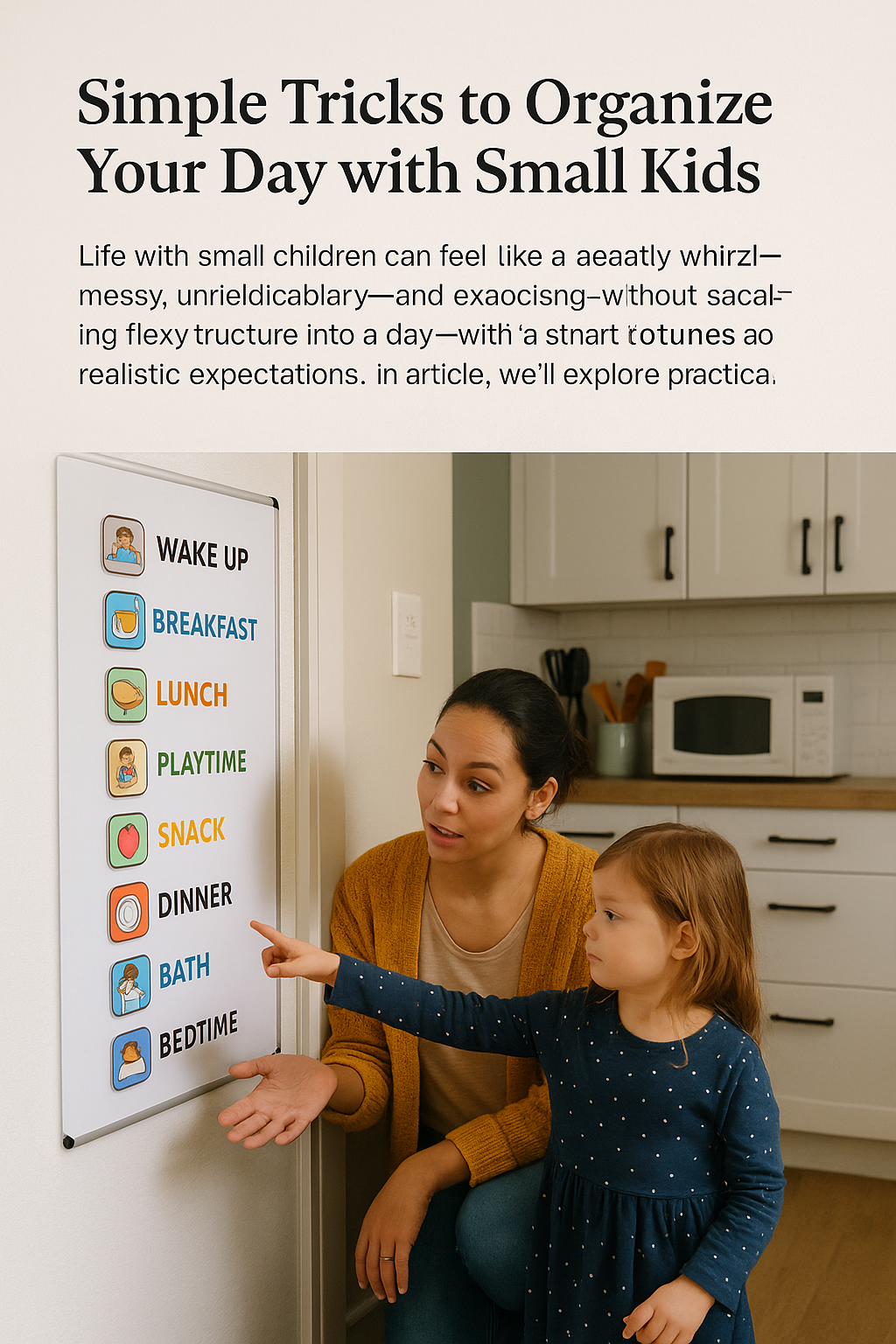Simple Tricks to Organize Your Day with Small Kids
Life with small children can feel like a beautiful whirlwind—messy, unpredictable, and exhausting. From diaper changes to snack time to tantrums, the day can slip away before you’ve had a chance to breathe. But with a few smart routines and realistic expectations, it’s absolutely possible to bring more calm and structure into your day.
In this article, we’ll explore practical, parent-tested tips to organize your day with little ones in tow—without sacrificing flexibility or joy.
Why Routines Matter (Even for the Messy Days)
Children thrive with predictability. When they know what to expect, they feel safer and more in control. But routines don’t have to be rigid—they can be flexible patterns that provide flow, not pressure.
A well-organized day helps:
- Reduce meltdowns
- Improve cooperation
- Build independence
- Decrease parental stress
And most importantly—it gives you back a little bit of mental space.
1. Create Anchors, Not Clocks
Instead of planning everything by the minute, build your day around predictable anchors. These are events that happen in the same order, even if the timing shifts.
Common daily anchors:
- Wake up
- Breakfast
- Outdoor time
- Nap or quiet time
- Snack
- Dinner
- Bedtime
This approach offers structure without the pressure of the clock.
2. Use a Visual Schedule
Young children often struggle with verbal instructions alone. A visual chart or routine board with pictures helps them understand what’s coming next.
You can use:
- Hand-drawn pictures
- Printed icons
- Magnet boards
Even toddlers can follow a visual “first this, then that” format. It builds independence and reduces resistance.
3. Prep the Night Before
Mornings are smoother when you prepare ahead:
- Lay out clothes
- Pack snacks or lunches
- Set up breakfast items
- Charge devices or nightlights
- Review your calendar
Spending just 15 minutes preparing the night before can save you an hour of stress in the morning.
4. Build “Buffer Zones” Into Your Day
When you have small kids, transitions take time. Build in extra minutes between activities to avoid rushing.
Instead of:
- “We have to leave NOW!”
Try:
- “Let’s get shoes on early, so we can leave calmly.”
Buffer time makes everything feel less urgent—and more enjoyable.
5. Embrace the Power of the “Activity Bin”
Have a few go-to bins or boxes with independent activities your child enjoys. Use them during phone calls, while prepping meals, or during quiet moments.
Examples:
- Stickers, crayons, and coloring books
- Small puzzles or sorting games
- Water play with cups and bowls
Rotate the contents every week to keep things fresh.
6. Plan One High-Energy Activity a Day
Toddlers and preschoolers need to burn off energy—and so do you! Scheduling one physical activity each day helps reduce restlessness and improves behavior.
Ideas:
- A walk around the block
- Dancing to music
- Playground time
- Indoor obstacle course
Bonus: they’ll nap or sleep better, too!
7. Have a Backup Plan for Chaos
Not every day will go smoothly—and that’s okay. Prepare a few “Plan B” ideas for days when things unravel:
- Movie picnic on the living room floor
- Bathtub play in the middle of the day
- Call a grandparent or friend for a virtual chat
- Quiet time with audiobooks and blankets
Flexibility is just as valuable as structure.
8. Set Realistic Goals (Very Realistic)
With small children at home, your to-do list needs to adjust. Instead of aiming for 10 tasks, focus on just 2–3 key goals for the day.
Examples:
- “Fold laundry and return one email”
- “Make a grocery list and vacuum the living room”
Everything else is a bonus. Progress, not perfection.
9. Include Your Child in Daily Tasks
Children love feeling helpful. Turn routines into bonding opportunities by involving your little one:
- Let them “wash” plastic dishes
- Give them a mini broom to help sweep
- Sing a song while tidying toys together
It may slow things down at first, but over time, it teaches independence and cooperation.
10. Protect Quiet Time (Even If Naps Are Gone)
Even if your child has outgrown naps, quiet time is still valuable. It gives everyone a reset.
Ideas for quiet time:
- Audiobooks
- Puzzles
- Books in bed
- Soft music and drawing
Let your child know this is a regular part of every day—just like meals or bedtime.
11. Use Timers for Transitions
Timers help children transition between activities without surprises or battles.
Try:
- “When the timer rings, it’s time to clean up.”
- “Five more minutes of play before we get ready for bed.”
It removes YOU as the bad guy and puts the focus on the tool instead.
12. Let Go of Perfection
Some days will feel smooth and productive. Others… not so much. That’s part of parenting.
- Let the dishes sit if the kids need extra snuggles
- Skip the laundry to enjoy story time
- Choose presence over productivity
Your child won’t remember if the house was clean—they’ll remember how safe and loved they felt.
Final Words: Organized Chaos Is Still Beautiful
You don’t need to be a super-parent with a flawless routine. You need small systems that support your energy, honor your child’s needs, and bring rhythm to the mess.
By adding just a little structure, a few smart tools, and a whole lot of grace—you’ll create a daily flow that feels good for everyone.
One step, one breath, one moment at a time. You’ve got this. 💛
